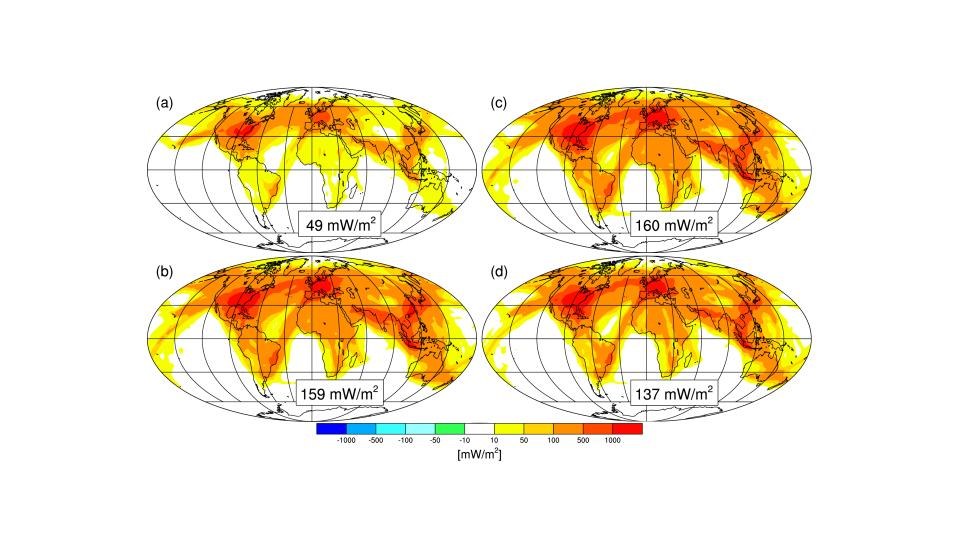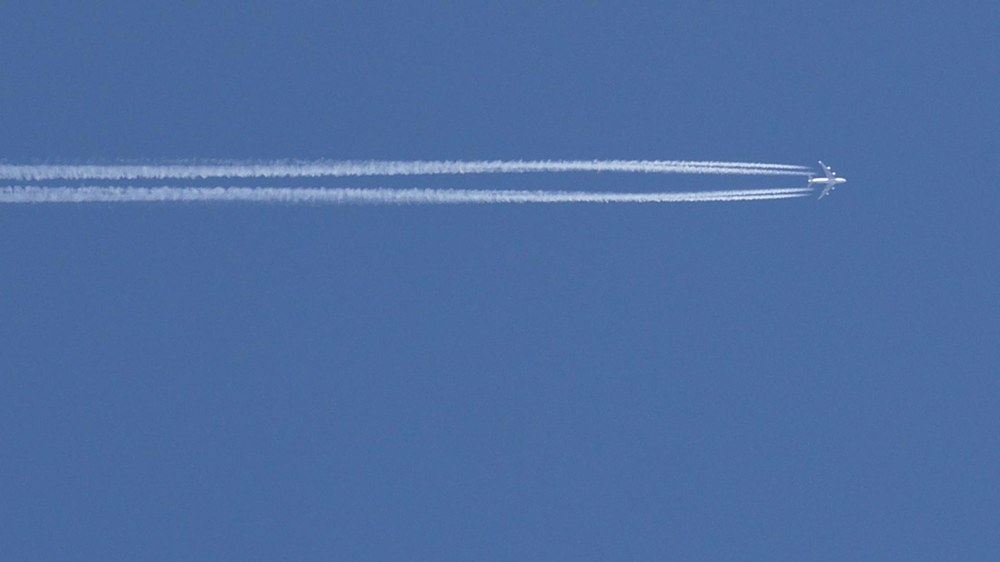Climate impact of clouds formed from aircraft condensation trails could treble by 2050



- In cold, damp conditions, soot particles emitted by aircraft cause the formation of ice crystals and condensation trails.
- Anthropogenic contrail cirrus clouds have an impact on the global climate.
- Important countermeasures include the use of alternative fuels with reduced soot particle emissions and the development of lower-emission aircraft engines.
- Focus: Aeronautics, atmospheric research, climate change, low-emission air transport
In cold and damp conditions, aircraft condensation trails and the cirrus clouds that develop from them can remain in the sky for many hours. Their impact on the global climate system has not yet been addressed in emissions trading agreements, which seek to limit aircraft emissions. Since the advent of aviation, contrails have contributed to the warming of the atmosphere to a similar extent as the overall carbon dioxide emissions from aircraft. The results of a study carried out by the German Aerospace Center (Deutsches Zentrum für Luft- und Raumfahrt; DLR), which were published in the European Geosciences Union (EGU) journal 'Atmospheric Chemistry and Physics' on 24 June 2019, show that the climate effects of contrails will increase significantly in the future, and will treble by 2050.
The UN climate protection concept 'Carbon Offsetting and Reduction Scheme for International Aviation' (CORSIA), which will be introduced from 2020 as a carbon dioxide compensation system for international aviation, overlooks non-carbon-dioxide-related climate effects of air transport such as contrail cirrus. "However, it is important to study the significant effects of non-carbon-dioxide emissions such as contrail cirrus clouds on the climate. These effects must also be taken into account when setting up emissions trading schemes such as CORSIA," says Lisa Bock of the DLR Institute of Atmospheric Physics and lead author of the study. Ulrike Burkhardt, co-author and also an atmospheric researcher at DLR, adds: "These effects are expected to increase even faster than carbon-dioxide-induced impacts, as carbon dioxide emissions per passenger kilometre are already declining and research into fuel-saving measures continues."
The researchers estimate that the effect of contrail cirrus clouds will be three times greater in 2050 than it was in 2006. Global air traffic is expected to quadruple over that same period. The climate effects of contrails will by far be the greatest over North America and Europe – the areas of the world with the most air traffic – but they will also increase significantly in Asia.
Bock emphasises that: "Research is currently being conducted into the contrail clouds themselves, as well as their impact on Earth's surface. So far, there is a great deal of uncertainty about the overall climate effects of these clouds, especially in terms of their influence on the surface temperature. But one thing is clear – they are warming the atmosphere."
Low-emission air transport
The number and size of the ice crystals at the time of contrail formation depends on the soot particle emissions from the aircraft engines. When the emissions are reduced, the number of ice crystals in newly formed contrails decreases, which limits the lifespan and climate effect of these anthropogenic, high-altitude clouds. Reducing soot emissions is thus an important step towards reducing the climate impact, but it is probably not enough. "Even if a 90 percent reduction in exhaust gas particles is achieved, it will probably not be enough to limit the climate impact of contrails to the 2006 level," says Burkhardt.
Another frequently-discussed idea is to avoid flights in regions where contrails with a major climate impact are able to form. However, Bock and Burkhardt warn against using methods that could lead to an increase in long-lived carbon dioxide emissions, especially in view of the currently uncertainties relating to the climate impact of contrail cirrus clouds. Measures that reduce soot emissions should be made a priority instead.
DLR research into the climate impact of condensation trails
In April 2011, researchers at the DLR Institute of Atmospheric Physics published an article in the journal ‘Nature Climate Change’ suggesting that contrail cirrus clouds are having a slightly greater impact on the climate than the total global carbon dioxide emissions from aircraft.
The effect of various alternative fuel compositions on the levels of particle emissions and the formation of ice crystals was investigated by DLR in cooperation with NASA in spring 2018, in the joint ND-MAX/ECLIF 2 (NASA/DLR-Multidisciplinary Airborne eXperiments/Emission and CLimate Impact of alternative Fuel) flight measurement campaign over Germany.
In January 2019, atmospheric researchers at DLR published the results of a study conducted using climate model calculations. The findings revealed that reducing the level of soot emissions from engines had a radical effect on the properties and lifetime of contrail cirrus clouds, and that making such change is vital, as the climate impact can be mitigated only by a significant reduction.
How condensation trails form and what they do
At altitudes between eight and 12 kilometres – typical cruising altitudes for passenger and freight aircraft – the soot particles in the engine exhaust plumes act as 'condensation nuclei' for water droplets. These droplets freeze to form ice crystals and then condensation trails. Depending on the position of the Sun, that is, the angle of the incident solar radiation, as well as the characteristics of the ground and the natural cloud cover, these anthropogenic clouds may have a cooling or warming effect. Some of the solar radiation is reflected by the cirrus cloud cover. This cools the atmosphere. The thermal radiation from the Earth’s surface, however, is blocked by the anthropogenic cloud layer, leading to greenhouse-type warming. Research shows that, overall, the warming effect outweighs the cooling process.
